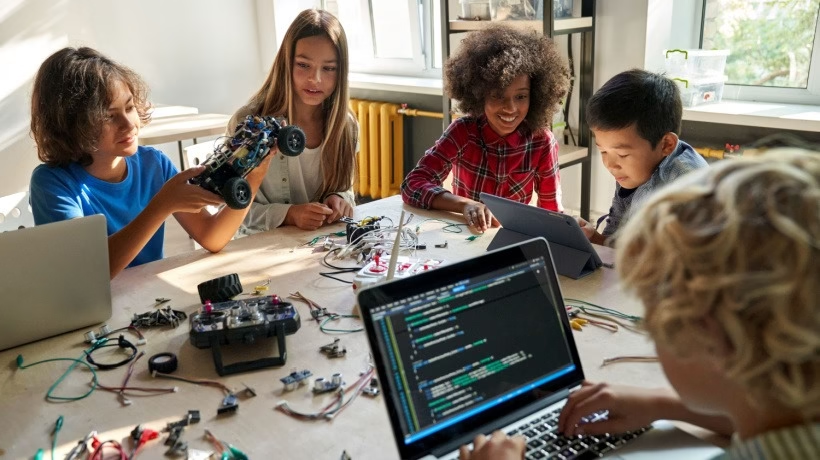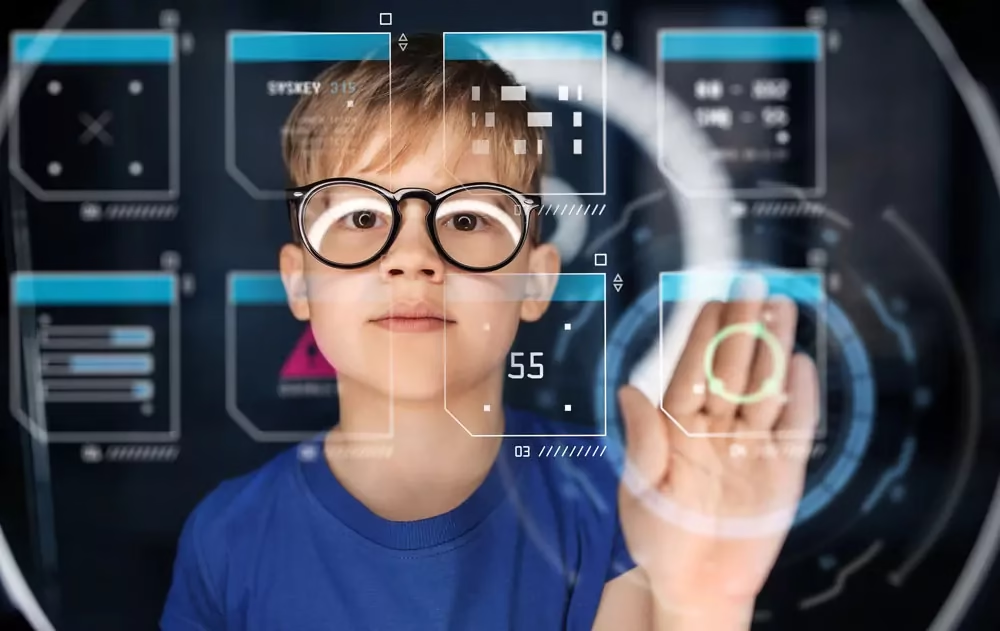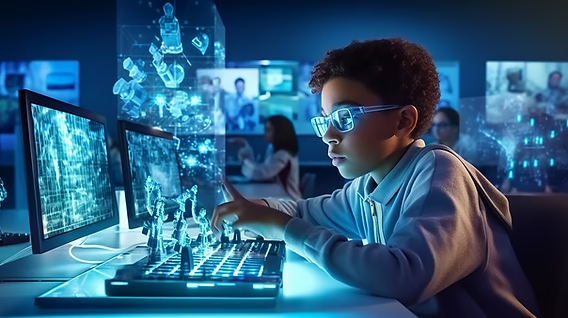What is Artificial Intelligence? – AI for Kids
The world changes through artificial intelligence through its transformation of contemporary fields. But what exactly is it? A computer or robot that functions under computer control possesses thinking abilities alongside problem-solving and learning functions identically to human capabilities. Computer systems receive mental processing capabilities through artificial intelligence which enables them to do jobs better performed by humans.
The technological advancement produces computers able to detect faces and convert speech into understanding while playing games and operating driving controls. That’s the power of AI. The process involves building computer-operated machines which acquire knowledge through experience while adapting to new data to autonomously produce choices.

Why is AI Education Important for Kids?
The technological environment has become so quick-paced that artificial intelligence spreads into different domains of human life. Voice assistants named Siri and Alexa together with streaming service recommendations have become significant transformations that AI has made to how people live their lives and conduct their work.
Several essential reasons exist for children to learn about AI fundamentals at a young stage.
- AI drives industrial transformation while establishing fresh professional positions which will exist in the future. Our purpose as educators should be to provide basic AI education at start so students can master the capabilities needed to succeed as AI takes over different parts of our future society.
- The process of learning about AI helps children to develop critical thinking skills by studying how technology affects society. The education enables students to acquire advanced comprehension about AI system functioning and its potential advantages along with ethical issues in AI employment.
- The combination of creative and innovative tools through artificial intelligence technologies provides students with an effective platform for creative exploration. AI education lets children discover innovative ways to create solutions as they learn in addition to finding new methods of artistic self-expression.
- A fundamental aspect of digital literacy consists of AI education learning. The education about AI systems helps children develop safe and responsible skills to use digital platforms through making well-informed choices about their interactions with AI systems.
How Early Can You Introduce AI Concepts?
The establishment of fundamental AI fundamentals among young children should begin at any age. The fundamental concepts of AI become accessible to preschool children through suitable communication and interactive tasks.
The introduction of AI concepts begins with discussing voice assistants Siri and Alexa with your children. You should ask your child if they have engaged with Siri or Alexa. They are examples of AI! The devices demonstrate two fundamental abilities to receive human speech and generate appropriate answers.
Storytelling provides an effective way to initiate explanations about AI principles. Have your child watch robot or AI character content in movies or read robot and AI-themed books before discussing their actions along with their capabilities with you. The discussion stimulates children to gain interest and begin questioning how AI operates.
When children reach older ages you should present more sophisticated AI topics to them including machine learning and natural language processing and computer vision. The introduction of AI concepts to children finds support in numerous educational resources that match their developmental stage through books and websites together with available online courses.
Fun and Engaging Ways to Introduce AI to Kids
Learning about AI shouldn’t be a dry and boring experience. There are many fun and engaging ways to introduce AI concepts to young learners and spark their curiosity. Here are a few ideas:
AI Toys and Games
The market is brimming with AI-powered toys and games designed to introduce children to basic AI concepts in a playful and interactive way. Here are a few examples:
- Coding Robots: These robots can be programmed to perform various tasks, teaching children the basics of coding and robotics, which are closely related to AI. Popular options include:
- Dash and Dot: These colorful robots are perfect for younger children, allowing them to learn about coding through playful activities and challenges.
- LEGO Mindstorms: This robotics kit allows older children to build and program their own robots, providing a more advanced introduction to robotics and AI.
- Smart Plush Toys: These cuddly companions incorporate AI to interact with children in a more personalized way. For example:
- CogniToys Dino: This interactive dinosaur can answer questions, tell stories, and even learn a child’s name and interests.
- Furby Connect: This furry friend uses AI to learn and adapt to a child’s personality, providing a unique and engaging experience.
- Educational Games: Many educational games incorporate AI elements to enhance learning and engagement. For example:
- AI-Powered Learning Apps: These apps use AI to personalize the learning experience, adapting to a child’s pace and providing customized feedback.
- Interactive Storytelling with AI: These platforms allow children to create their own stories with the help of AI, encouraging creativity and imagination.
AI in Everyday Life
Modern artificial intelligence exists in the environment where we live right now. For children to identify AI in their everyday experiences point out the following examples:
- Children routinely access familiar AI examples through their interactions with three main voice assistants that include Siri, Alexa and Google Assistant. Show children how AI systems detect spoken instructions and answer queries through this description.
- AI systems at streaming services suggest films songs and videos directly from user past choices. Explain how these customized suggestions are created with AI system programs.
- AI systems filter email to stop messages from spammers. Describe how AI system supports email safety by filtering out unwanted spam messages.
- Recognizable daily examples demonstrate to children that AI exists as an authentic technology which affects their experience today.
Creative Activities with AI
AI creates effective ways to express artistic ideas at the same time. Guide your children to use AI-enabled platforms which provide them the following capabilities:
- AI tools now provide children with methods to generate artistic pieces while composing music and crafting narratives by writing stories based on their input. AI tools function as creative catalysts which simultaneously show users innovative types of artistic production.
- Children can develop outstanding visual and animated content through AI systems such as DALL-E 2 and Stable Diffusion. The creative use of AI provides children with an exciting experience that helps them discover AI’s creative capabilities.
- These creative AI tools should be used by children to stimulate their curiosity and allow them to gain experience in AI possibilities.

Learning Resources for AI Education
As AI becomes increasingly important, numerous resources are available to help kids learn about this exciting field. Here are some excellent options:
Books and Websites
- Books:
- “Artificial Intelligence for Kids” by David Whale: This book provides a gentle introduction to AI concepts for younger children, using simple language and engaging illustrations.
- “Hello World: Being Human in the Age of Algorithms” by Hannah Fry: This book explores the ethical and societal implications of AI, making it a great choice for older children and teenagers.
- “The AI Book: The Artificial Intelligence Handbook for Investors, Entrepreneurs and FinTech Visionaries” by Susanne Chishti and Janos Barberis: While aimed at adults, this book offers accessible explanations of various AI concepts and applications, making it a valuable resource for older kids and parents.
- Websites:
- AI4K12: This website provides a comprehensive curriculum for AI education, with resources and activities for different age groups.
- Machine Learning for Kids: This interactive platform allows kids to train their own machine learning models and explore AI concepts through hands-on projects.
- Khan Academy: This popular online learning platform offers courses on AI and computer science, suitable for older kids and teenagers.
Online Courses and Programs
- Online Courses:
- Elements of AI: This free online course provides a comprehensive introduction to AI for learners of all ages, including children.
- Code.org: This platform offers various coding courses that incorporate AI concepts, such as machine learning and natural language processing.
- Coursera and edX: These platforms offer a wide range of AI courses, some of which are suitable for older kids and teenagers with a strong interest in AI.
- Coding Programs:
- Scratch: This visual programming language allows kids to create interactive stories, games, and animations, introducing them to basic programming concepts that are relevant to AI.
- Python: This popular programming language is widely used in AI development. There are many online resources and courses that teach Python to kids, providing a foundation for future AI learning.
AI Clubs and Workshops
- AI Clubs: Many schools and community organizations are starting AI clubs for kids, providing a space for them to learn about AI, collaborate on projects, and connect with other like-minded learners.
- Workshops: AI workshops offer hands-on learning experiences, allowing kids to explore AI concepts through interactive activities and challenges. Many organizations, such as universities and tech companies, offer AI workshops for kids.
By exploring these various learning resources, you can provide children with a rich and engaging AI education that caters to their individual interests and learning styles.
Addressing Concerns and Ethical Considerations
People need to handle AI’s benefits properly as well as manage ethical issues during child-related AI use.
AI Safety and Privacy
- Show young learners how to handle AI tools properly and ethically while using these systems. Teach children about the security dangers of online sharing and explain why their personal data needs protection.
- Demonstrate how artificial intelligence units access and deal with data and describe why personal data security matters to everyone. Show children how to decide which personal details they reveal online and how to set their privacy tools.
- Age-Appropriate Guidelines: Establish age-appropriate guidelines for interacting with AI systems, such as voice assistants and social media platforms. Describe what harm online dangers can bring and why children need parent support.
Bias and Fairness in AI
These AI programs retain structural biases from their program design. Explain how facial recognition systems fail to work properly with people who are not white.
- Fairness and Ethical Considerations: Encourage critical thinking about fairness and ethical considerations in AI development. Examine what procedures need to be taken to develop AI systems that show fairness and eliminate bias. When AI contains biased programming what effects could result. How can we use AI for good?
- Presenting these worries and moral aspects will show children how AI affects our society as they think critically about the technology.
Inspiring Future AI Innovators
Letting children see how AI works builds their interest and motivates them to become leading AI creators of tomorrow. Follow these steps to motivate children.
Showcasing AI Role Models
- Display the work of leading AI researchers and scientists who develop new technology in this field to children. Show the children how AI experts reached their success while navigating their problems to motivate them toward AI study.
- Introduce young teens who created exceptional AI products and defeated rivals in artificial intelligence events. Any person at any age can explore AI subject matter and become part of the field.
Encouraging Creativity and Exploration
- Guide children to build future AI ideas by using their imagination. Inquire from students which issues AI technology might address right now. What steps can AI take to improve our world environment? Show me what you can develop using the power of artificial intelligence.
- Equip children through practical experiments with AI equipment to develop their knowledge. Help kids experiment no matter what they learn through their testing. Mistakes are valuable learning opportunities.
- Helping children discover new possibilities in AI development will lead them to become future leaders of artificial intelligence technology.

Conclusion
The necessity of Artificial Intelligence education surpasses luxury status in the present technology-driven landscape. Students will gain essential knowledge and abilities to succeed in an AI-overloaded society through learning about AI concepts from an early age. We establish a future-oriented generation by offering interesting lessons alongside easy-to-reach learning tools and important exchanges thus creating individuals who think critically solve problems creatively and make ethical innovations which define AI advancement.
Starting the dialogue about AI with children should take place right from the beginning. Take advantage of the moment to show young students how AI functions while preparing them to see the many chances AI brings to their world.
References
- AI4K12: https://ai4k12.org/
- Machine Learning for Kids: https://machinelearningforkids.co.uk/
- Khan Academy: https://www.khanacademy.org/
- Elements of AI: https://www.elementsofai.com/
- Code.org: https://code.org/
